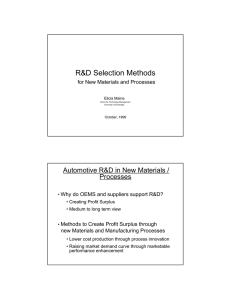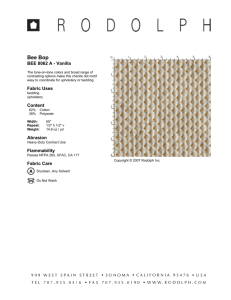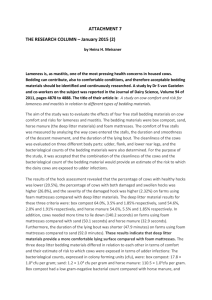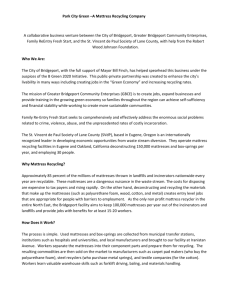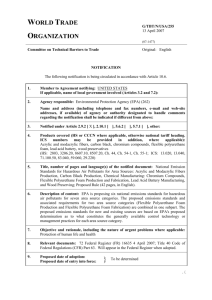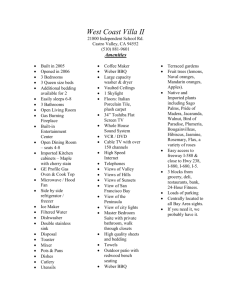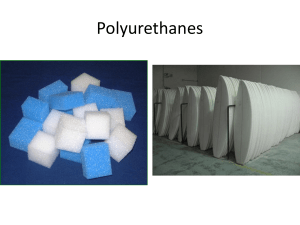Sustainable Purchasing Guide Bedding
advertisement
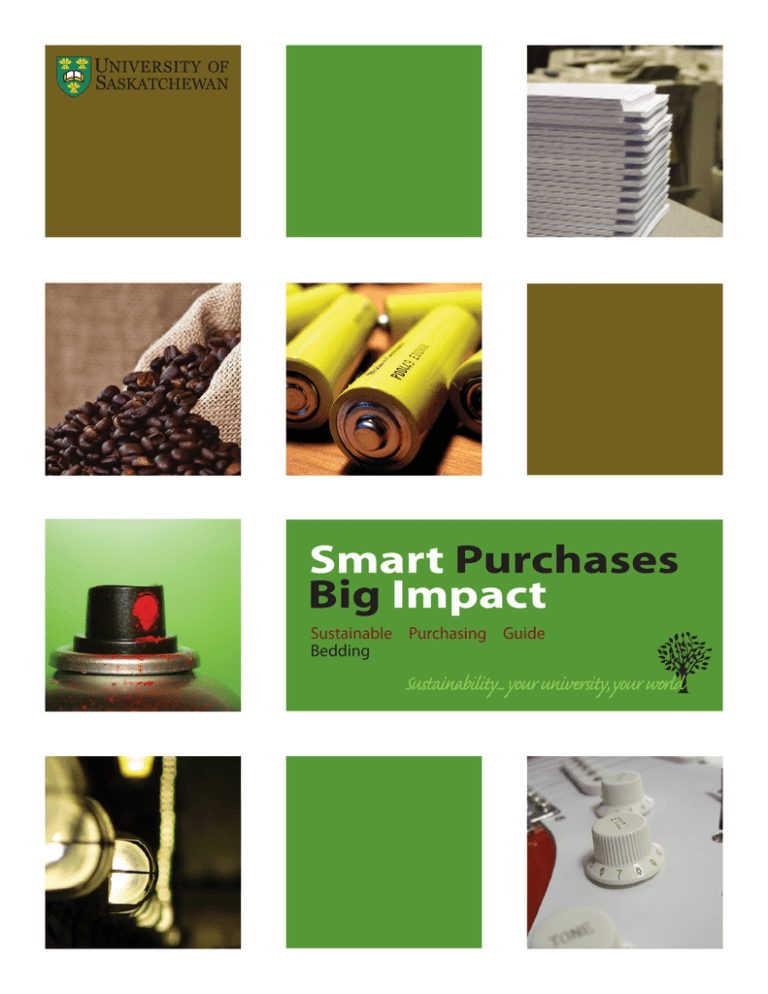
Sustainable Purchasing Guide Bedding Bedding Introduction This section provides information on currently available bedding options that can help to move the University of Saskatchewan toward its sustainability goals. Living within the boundaries of our sustainability objectives requires us to apply two main strategies: Dematerialization requires that we reduce the amount of materials as much as possible; and that we continually move toward the use of 100% recycled content. Substitution requires that we find less harmful materials to replace those that currently damage and are not recyclable. Sustainable purchasing is about including social, environmental, financial and performance factors in a systematic way. It involves thinking about the reasons for using the product (the service) and assessing how these services could be best met. If a product is needed, sustainable purchasing involves considering how products are made, what they are made of, where they come from and how they will be used and disposed. Finally, remember that this is an evolving document – it will change with new information as our understanding of sustainability impacts and potential solutions improves. Purchasing Services Tel: Email: (306) 966-6704 purchasing.services@usask.ca Office of Sustainability Tel: Email: (306) 966-1236 fmdsustainability@usask.ca Wherever possible CHOOSE products that employ a combination of characteristics listed in the left hand column, and AVOID products that demonstrate characteristic in the right-hand column. CHOOSE AVOID • Products made without poly­ brominated diphenyl ethers • Products manufactured in Canada • Encased products to reduce exposure chemical exposure • Natural rather than synthetic fibres • Natural latex foam • Products made with polybrominated diphenyl ethers • Products made outside Canada • Wrinkle-resistant fabrics treated with formaldehyde • Polyurethane foam Option: Choose Canadian-made products Strategy: Substitution (SO 2) Choose mattresses and pillows made in Canada or to Canadian standards. Imported products may contain polybrominated diphenyl ethers, a group of flameretardants and stain inhibitors that have been linked to cancer, birth defects and fertility problem. It is banned in Canada. Where materials are being supplied for manufacturers serving the entire North American market, fire retardants are used to conform to the fire requirements in other jurisdictions. For instance, some products made to supply both the U.S. and Canada are made with different fire retardants, known as chlorinated phosphate esters, or TCEP. While not environmentally persistent like PBDEs, they are potentially toxic and the European Union may soon be taking action to regulate them. An added benefit of buying Canadian is the reduction of fossil fuel needed to transport the product. Option: Choose natural latex Strategy: Substitution (SO 2) The manufacture of polyurethane involves the reacting of toluene diisocyanate (TDI) with a polyol, an alcohol-based substance that has, in turn, been created by a prior chemical reaction with another ingredient called methyloxirane (also known as propylene oxide). Both TDI and methyloxirane are carcinogenic chemicals. Recently, some manufacturers have introduced soy-based polyurethane in an effort to address concerns about toxicity and uses of non-renewable petroleum-based polyols. While it may be greener than conventional polyurethane, it still poses problems. Soybean oil can only replace a small percentage of the polyol, typically 5-40%, so the remainder must still be provided by petroleum-based polyols. More importantly, TDI is still used to create the final product. continued on page 2 … Sustainable Purchasing Guide 1 The best alternative to polyurethane in furniture and mattresses is natural latex, which is derived from the rubber tree plant and is a renewable resource. It holds its shape well and latex mattresses can last much longer than polyurethane-based products. Synthetic latex is also widely used in products. It is better than polyurethane in that it does not pose a risk to consumers, but workers are exposed to a carcinogen – styrene – in the production process, because most are made from a styrene-butadiene polymer. Although difficult to come by and more expensive than other alternatives, there are alternatives to conventional mattresses, including those made with wool, cotton or natural latex. Option: Choose natural fibres When products are immediately wrapped in plastic after manufacture there is no opportunity for dissipation of chemicals in the products and consumers are subject to exposure upon first use. Give new bedding ample opportunity to off-gas and purchase appropriate barrier encasing to reduce exposure to emissions. Strategy: Substitution (SO 1, 2) Choose natural, and where possible, organic fibres. For pillows, organic wool or goose down pillows are preferred options to polyurethane, assuming there are no allergies. Barrier encasing can reduce the potential for allergic reactions. For sheets, blankets and comforters, natural (preferably organic) materials are preferred to synthetic materials, such as polyester. Many synthetic materials are made of petro-chemicals, a nonrenewable resource. In addition, synthetic fibres do not breathe the way natural fibres do, and they can off-gas chemicals. Option: Reduce exposure to harmful emissions Avoid wrinkle-resistant bedding, which is treated with formaldehyde (a carcinogen). In the case of mattresses and pillows, exposure can be further reduced by wrapping them in plastic or a high-thread-count cotton barrier encasing or (mattresses only), cotton padding wrapped around the foam core. Plastic will off-gas chemicals, so natural cotton barrier cloth is more preferable. Natural cotton barrier cloth is an excellent way to reduce exposure to mattress emissions and also protects against small allergen particles including dust mite and animal allergens. Arriving at the currently preferred options 1. Identify the service 3. Identify the contents Mattresses, pillows, sheets and blankets are provided in some university residences. 2. Assess the need Mattresses are made of a variety of materials, which may include polyurethane. Petroleum-based synthetic fibres, such as polyester, are commonly used as covering materials. Depending on their point of manufacture, mattresses may be treated with fire retardants. Quality bedding is needed to ensure the comfort of the students and short-term guests staying in residence. Pillows may be made of natural materials such as feathers, wool and cotton, or man-made materials such as polyurethane and synthetic fibres or a combination of both. Sheets, blankets or comforters may similarly be made of a variety of either natural or man-made fibres. Wrinkle-resistant bedding is treated with formaldehyde. continued on page 3 … Sustainable Purchasing Guide 2 4. Identify sustainability impacts i. …systematically increasing concentrations of substances from the earth’s crust? Fossil fuels are combusted to provide energy during the extraction of raw materials, transportation, and production of bedding products. The combustion of fossil fuels leads to an increase in concentration of substances extracted from the earth’s crust in nature (CO2, CO and SOx). Increasing concentrations of these substances in nature can contribute to a number of negative effects such as climate change and acid rain, as well as to negative human health impacts. Petroleum is also used as a feedstock for many synthetic fibres, such as polyester, as well as for polyol, a component of polyurethane. Petroleum is a material that is extracted at a rate much greater than its redeposit back into the earth’s crust. ii. …systematically increasing concentrations of substances produced by society? Many mattresses and pillows contain polybrominated diphenyl ethers (PBDEs), a group of flame-retardants and stain inhibitors that have been linked to cancer, birth defects and fertility problems. Until about five years ago, manufacturers of foam used in mattresses and upholstered furniture routinely treated the foam with PBDEs. Biologists have also discovered that PBDEs are persistent in the environment and are showing up in the blood and tissue of orcas, grizzly bears and salmon, as well as the breast milk of women. Research into their health effects continues. Some products supplied in both the U.S. and Canada may be made with fire retardants known as chlorinated phosphate esters, or TCEP. While not environmentally persistent like PBDEs, they are potentially toxic to humans. The European Union may soon be taking action to regulate them. Formaldehyde is used to treat wrinkle-resistant bedding. Formaldehyde is applied with heat so it is permanently trapped in the fibre. According to the International Agency for Research on Cancer, formaldehyde is a cancer-causing substance and classified as a probable human carcinogen. It is also suspected that formaldehyde causes allergic reactions in a significant part of the population. The primary ways that people are exposed are through inhalation or absorption through the skin. Flexible polyurethane foam is a chemical polymer that retains its resilience and can be easily cut to shape, making it useful for hundreds of applications. The basic manufacturing process involves the reaction of toluene diisocyanate (TDI) with a polyol, an alcohol-based substance that has, in turn, been created by a prior chemical reaction with another ingredient called methyloxirane (also known as propylene oxide). Both TDI and methyloxirane are carcinogenic chemicals to which workers may be exposed in the manufacturing process. Both types of TDI used in foam manufacturing are classified as possible human carcinogens (Group 2B) by the International Agency for Research on Cancer. It’s not expected that consumers are directly exposed to TDI or methyloxirane in polyurethane furniture or mattresses, although there is evidence that it could cause reactions as the polyurethane breaks down and becomes part of house dust. In addition, because polyurethane poses a fire hazard, fire retardants are often added. iii …systematically degrading nature by physical means? Polyurethane does not break down in landfills. This contributes to the physical degradation of nature through increasing amounts of land used for landfill. Similarly, many synthetic, petroleum-based fibres do not break down with time. iv. …systematically undermining people’s ability to meet their basic human needs? A number of the compounds produced by the combustion of fossil fuels and other processes to create bedding products (e.g. polybrominated diphenyl ethers, chlorinated phosphate esters, or TCEP, formaldehyde, toluene diisocyanate, and methyloxirane) negatively affect human health. 5. Envision sustainable bedding What would sustainable bedding look like? Sustainability requires that materials be kept within natural cycles (where materials can be easily assimilated by nature) or tight technical cycles (where materials can be reused indefinitely in processes that do not move us away from our sustainability objectives). Sustainable bedding would not contribute to systematic increases of substances extracted from the earth’s crust, or of human-made substances. This means that it would either (1) not contain any substances that could systematically increase in nature or (2) that these substances would be taken back and re-used entirely. Bedding would either be produced from bio-based materials that natural ecosystems can easily assimilate, or be 100% recycled. The energy used for extracting raw materials, producing and transporting the bedding would be generated from sustainable renewable sources in a carbon-neutral way, so that no carbon was allowed to systematically increase in the atmosphere and biosphere. continued on page 4 . . . Sustainable Purchasing Guide 3 6. Identify and prioritize alternatives To identify the best options, review the Current Options on page one and choose the most appropriate alternative by using the following three criteria for assessment: a)Does the product or service move us in the right direction with regards to our four Sustainability Objectives? b)Does the product or service create a flexible platform for the next step toward sustainability? c)Is the decision financially viable? Resources and Additional Information 1. Chemical Substances. www.chemicalsubstanceschimiques.gc.ca/ challenge-defi/bisphenol-a_fs-fr_e.html 2. Labour Environment Society. www.leas.ca/Frequently-Asked-Questions.htm 3. How Green is Your Home? www.todaysparent.com/lifeasparent/article.jsp? content=20080219_160824_6200&page=2 4. Healthy and Green Living; Conscious Consumer. http://www.care2.com/greenliving/consciousconsumer 5. Cheap Mattresses May be Health Hazards. www.thespec.com/article/325353 This guide was made possible through the generosity of the Whistler 2012 project, which shared its template and much of its research. Sustainable Purchasing Guide 4
